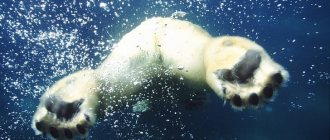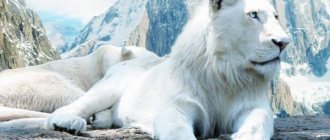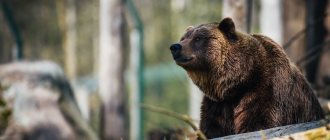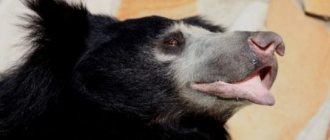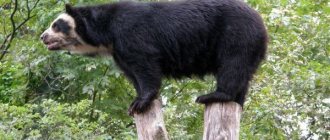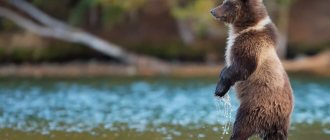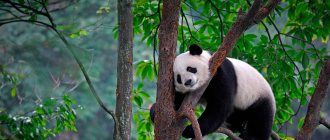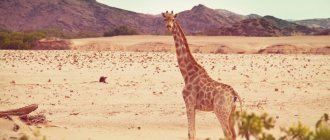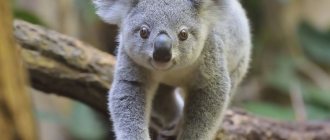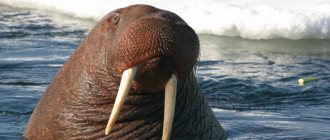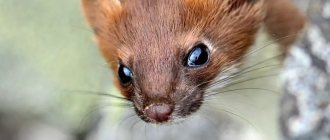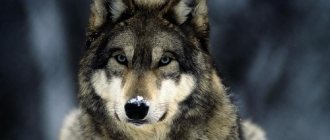Description and features
This bear is larger than a lion and a tiger. Where are exotic predators compared to our Russian polar beast! Its length reaches 3 meters. Although most often 2-2.5 m. And the mass of a polar bear is almost half a ton. An adult male weighs 450-500 kg. Females are much smaller. Weight from 200 to 300 kg. Body length is from 1.3 to 1.5 m.
The height of an adult animal most often reaches 1.4 m. These dimensions correspond to the colossal strength of the animal. There are frequent examples when a bear easily carried away a large prey, a reindeer or a walrus.
Even more dangerous is the extraordinary agility of this beast, which is even difficult to believe considering its weight. His appearance is different from other bears. First of all, it's really white. More precisely, its fur ranges from white to light yellow. In winter it is lighter, in summer it turns yellow under the sun.
The polar bear in the photo looks more impressive against the backdrop of its native expanses. His appearance there almost merges with the ice hummocks, one black nose and eyes stand out against the general background. It becomes clear how advantageous the white color is in nature for this animal.
Unlike an ordinary bear, it does not have a stocky body, but a “runaway” one. Long neck, flat head, long and sensitive nose. There is evidence that it can smell the desired prey even under a meter-long layer of ice.
Nature generously took care of his “clothing”, given the harsh polar conditions. Its coat is thick and long, it has good thermal insulation properties. The fur is hollow and allows the rays of the sun to pass through.
And the skin under the fur is dark, and warms up better, retaining heat. The legs of the predator are very powerful, ending in large paws. The soles of his paws are lined with wool so that he does not slip on people and does not freeze.
There are membranes between the fingers, they help him swim. The front surface of the paws is covered with stiff bristles. Hidden underneath are large claws that allow you to grab and hold prey until you reach it with your teeth.
The jaws are large, well developed, with up to 42 teeth. The polar bear's tail is small, from 7 to 13 cm. It is practically invisible under the long hair on the back of the back.
The beast is distinguished by endurance and agility. Being a close relative of the brown bear, it is not nearly as clumsy. It can quickly and tirelessly run up to 6 km on land, accelerating up to 40 km/h, after patiently tracking down the victim. It sneaks up perfectly, deftly chooses the right moment, taking advantage of uneven ground, and attacks by surprise and quickly.
He swims and dives well. Can swim quite a distance, at speeds up to 7 km/h. Sailors traveling through the northern seas have repeatedly encountered polar bears swimming in the open sea far from the shores.
Let's add to all this the extraordinary courage of the polar owner and terrible ferocity, and it will become clear why in the northern latitudes all living things are afraid of this tyrant. Only the walrus, armed with long fangs, enters into a fight with the northern bear. And the man, picking up a firearm, also challenged the beast. Although, this was precisely one of the reasons for the catastrophic disappearance of this amazing animal.
Chukotka Autonomous Okrug
Status: IV category. The status of the population has not been determined; additional scientific research is required.
Spreading
Within the Chukotka Autonomous Okrug there is a Chukotka-Alaskan population of the species, conditionally limited from the east by Cape Barrow (Alaska), from the west by the mouth of the river. Kolyma and Bear Islands. Animals from neighboring geographical groups may enter. The permanent habitat covers the ice cover, islands and coast of the Polar Basin. Together with drifting ice, it moves to the Bering Sea and actively roams throughout the entire water area of the Anadyr Bay basin. From here it moves north along the sea coast and along the inland areas. The southern limit of regular visits is the Koryak coast, but visits are also known to Kamchatka, the Sea of Okhotsk - all the way to Japan.
The areas where ancestral dens are constructed are confined to the coast of the East Siberian and Chukchi Seas, as well as the Bering Strait. The main breeding ground is Wrangel and Herald Islands.
Number
By the end of the 1980s. The size of the Chukotka-Alaskan population was estimated at 2.5-7.0 thousand animals, which allowed it to be considered restored. However, the weakening of ice cover in the eastern Arctic and the sharp expansion of illegal fishing in the 1990-2000s. created the preconditions for the current decline in numbers. Currently, the population size is estimated only at the lower limit (2000+), since reliable counts have not been made.
Source: Red Book of the Chukotka Autonomous Okrug. Volume 1. Animals. Chereshnev I.A., Andreev A.V., Berman D.I., Dokuchaev N.E., Kashin V.A. (2008) Ed. house "Wild North"
Kinds
We consider the polar bear's closest relatives to be the brown bear, grizzly bear, Malayan bear, baribal (black bear), Himalayan bear and panda. All these bears are omnivorous, climb well, swim, run fairly quickly, and can stand and walk for quite a long time on their hind legs.
They have long thick fur, a short tail and an excellent sense of smell. The nose is a very sensitive organ for them. One bee that stings your nose can take a predator out of its rut for a long time.
The brown bear is the most famous representative of this group. Distributed over a fairly vast territory of Eurasia - from Spain to Kamchatka, from Lapland to the Atlas Mountains.
There are small deviations from the general type (red bear, roan - Syrian), but they are insignificant. It retains its typical appearance throughout its habitat: large (up to 2 m in length, weight up to 300 kg), heavy-set, club-footed. The coat is thick, brown in color, the head is large.
The bear has a dangerous, but not insidious disposition. The character of this animal is based on a love of peace and phlegmatism. The silver or gray bear lives in North America. They call him a grizzly bear. It is larger than its brown counterpart, reaching 2.5 m, heavier (up to 400 kg) and incomparably stronger.
Immediately striking are its long body with shaggy dark brown hair, a flat, wide forehead and huge paws armed with strong claws up to 12 cm in length. This predator, unlike the first, is ferocious and treacherous.
There are terrible stories about his character. It’s as if he doesn’t know whether he was hit or not. It is enough for him to see a person to attack him. It is very difficult to hide from him; he runs fast and swims well.
It is not surprising that the natives of North America considered it the highest feat of a man to measure his strength with such an opponent. Whoever defeated him and made himself a necklace from the bones and teeth of a grizzly bear was held in great esteem by the tribe.
Much more good-natured than this relative is another American bear - the baribal, or black bear. It has a sharper muzzle, is somewhat smaller than a grizzly bear, has short feet and long, coarse fur of a glossy black color.
One of the representatives of Asian bears is the Himalayan bear. The Japanese call it kuma, the Hindus call it balu and zonar. His body is more slender than that of his fellows, his muzzle is pointed, his forehead and nose form an almost straight line.
The ears are large and round, the feet are short, and the claws are also short, although strong. The fur is uniformly black in color and has a white stripe on the chest. The size is up to 1.8 m, and everything is about 110-115 kg. In its lifestyle it resembles a brown one, only much more cowardly.
The Malayan bear, or biruang, is found in Indochina and the Greater Sunda Islands. He is long, awkward, has a large head with a wide muzzle, small ears and blind eyes.
Disproportionately large paws end in strong claws. The coat is black, with roan-yellow spots on the face and chest. Smaller than others, length up to 1.5 m, weight up to 70 kg. Favorite delicacy: coconut plantations.
And finally, the panda is a bamboo bear. Although some dare to classify him as a raccoon. Lives in China. The color is black and white, with the famous black circles around the eyes. Ears and paws are black. It can reach 1.5 m in length and weigh up to 150 kg. Likes to eat young bamboo shoots. Is a symbol of China.
Paths of evolution
Scientists have long believed that the development paths of the polar and brown bear diverged approximately one hundred and fifty thousand years ago. And this happened in the area of the planet occupied by modern Ireland. But recent research data has forced us to change this point of view. Today, science suggests that the separation of species occurred much earlier - on average, about six hundred thousand years ago. Over this long period, animals developed differences related not only to their habitat, nutritional conditions, but also to their appearance, although the genetic material indicates that these animals once had a common ancestor.
What is also common is the sad fact that all bears today are endangered animals. The polar bear, brown bear, Himalayan bear and other species of these unique animals need protection that only humans can give them. Although, it was he who became the main reason for the reduction in their numbers on Earth.
You can learn everything about the polar bear, as well as its relatives, on the pages of numerous publications, which contain research by scientists and stories of people who have encountered these unique and at the same time very dangerous animals in nature.
It must be said that the meeting did not always end happily, without sad consequences, if a person and a polar bear became its participants. The Red Book appeared because people sometimes tried to prevent the actions of a predator and destroyed it before it itself attacked a person or his home. But people’s actions were not always reasonable enough, and this ultimately led to a reduction in the number of polar bears.
Lifestyle and habitat
Polar bears live in the polar regions of the planet's northern hemisphere. He is an inhabitant of the Northern icy latitudes. In Russia, it can be seen on the Arctic coast of Chukotka, in the gulf of the Chukchi and Bering seas.
Its Chukotka population is now considered the largest on earth. According to research, the largest representatives live in the Barents Sea, while smaller individuals live near the island of Spitsbergen. To forestall possible questions, we inform you that there are no polar bears in Antarctica. His homeland is the Arctic.
The northern owner inhabits places close to water. Can swim on drifting and fast sea ice. It makes seasonal migrations along with changes in the boundaries of polar ice: in the summer it moves with them closer to the pole, in the winter it returns to the mainland. For the winter it lies in a den on land.
Females usually go into hibernation while awaiting the birth of cubs. During this period, they try not to move so as not to harm future offspring. Hence hibernation. It lasts 80-90 days. Males and other females who are not expecting offspring can also sometimes hibernate, but not for long and not every year.
The bear is an excellent swimmer, and its thick, dense fur perfectly protects it from cold water. A thick layer of subcutaneous fat also helps protect against cold. The animal easily hides in ice and snow, senses prey several kilometers away, and is almost impossible to escape or swim away from.
Early polar explorers repeatedly frightened with tales of the ferocity of this beast. They said that he did not hesitate to penetrate ships frozen in ice in order to obtain food.
A whole group of them ruled the deck, absolutely not afraid of the sailors. They repeatedly attacked wintering quarters, destroyed travelers' huts, and broke the roof, trying to break through.
However, later stories of polar explorers made much more modest mention of the ferocity of this beast. Even without a weapon, it was enough for a person to shout loudly to scare the animal and cause it to flee. The quiet silence of the ice taught him to be afraid of loud sounds.
A wounded animal always runs away. He hides in the snow to heal. However, if a person decides to attack cubs or enter the beast’s lair, he becomes a serious adversary. Then even a firearm cannot stop him.
He is cautious and curious, but not cowardly. They say that when people came across a polar bear, they fled for their lives. And then the predator began to chase them. Along the way they threw their things - hats, gloves, sticks, something else.
The beast stopped every time and methodically sniffed the finds, examining each item with curiosity. It was not clear whether the bear was chasing people or was interested in their household items. As a result, it was thanks to the curiosity of the predator that people managed to escape from it.
Usually bears live alone, without creating large family groups. Although, when forced to gather, hierarchy and discipline are established between them. The largest predator is always the most important. Although they are quite loyal to each other. Only for small bear cubs can adult bears sometimes become dangerous.
Polar bears caught in their youth can live successfully in captivity and become accustomed to people. They require frequent bathing; it is even better for them to wallow in the snow. Regarding food, there is little trouble with them, since they eat everything - meat, fish, and honey. They are quite unfriendly with other bears in captivity. In old age they become very irritable. There are cases where they lived up to 25-30 years and even reproduced.
Nenets Autonomous Okrug
Status: III category. Rare view.
Spreading
In the Nenets Autonomous Okrug it lives in the area of the Vaygach, Matveev and Dolgiy islands, on the Kara coast; regular encounters are observed along the coast of the Barents Sea in the Bolshezemelskaya and Malozemelskaya tundras, right up to the Czech Bay. To the west of Kolguev Island it is found only in conditions of high sea ice cover.
Number
The size of the Kara-Barents Sea population at the beginning of the 80s was estimated at 3000-6000 individuals, at the beginning of the 90s. - 2500-5000 individuals. The annual population growth is about 5-10%/
Source: Red Book of the Nenets Autonomous Okrug. Ed. Matveeva N.V., Lavrinenko O.V., Lavrinenko I.A. (2006) Naryan-Mar
Nutrition
The polar bear is an animal born for hunting. Everything is beneficial - webbed feet for swimming, a good sense of smell, sharp eyesight, and excellent hearing. He runs, jumps, swims, camouflages. His status as a hunter is unsurpassed in the North.
Any creature in sight can become its prey. It hunts on land and in water, eating meat and fish. Favorite prey is seal and bearded seal. He is able to smell them through the thickness of the ice, and then patiently watch over the hole. Or attack right in the water. It kills the prey, then begins to consume the skin and fat. This is the preferred body part of prey.
They practically do not eat fresh meat, making preparations for the hungry period. This menu helps them accumulate vitamin A to survive the cold and winter. The hunter's victims can be seals, young walruses, beluga whales, narwhals, and fish. On land, he is able to catch reindeer, wolves, and arctic foxes.
Sometimes, under the spring snow, they dig up roots to diversify their protein food. To get enough, he needs up to 7 kg of food. And a hungry predator may need more than 15 kg.
If the victim managed to escape from him, and he has no strength left for a new hunt, then the food is fish, carrion, bird eggs, and chicks. It is at the moment of forced hunger strike that he becomes especially dangerous. It can wander to the outskirts of human settlements, climb into garbage garbage and even attack a person.
He does not neglect algae and grass, quickly using up fat deposits. These are mainly the summer months, about 120 days. What the animal eats at this time cannot be classified at all. He eats almost everything.
In nature, an animal has few enemies. Only adult walruses are able to repel him with their tusks. And small bear cubs can be harmed by a pack of wolves or dogs. The main danger for him was and remains man. Poachers kill it for its luxurious skin and large amounts of meat.
Yamalo-Nenets Autonomous Okrug
Status: III category. Rare view.
Spreading
Bears of the Kara-Barents Sea population are found on the territory of the district. The area of usual habitat in the Kara Sea is north of 73º34′ N. latitude. The highest concentration of bears in the winter-spring period is observed on the traverse - the Kara Gate, Yugorsky Shar straits - the Sharapov Koshki archipelago - the mouths of the Gydan and Yenisei bays. Along this line they are most often observed on land: the mainland coast and islands. Some cases of encounters were found further south: in the area of. Levdiev, village Cape Kamenny and the village. Gyda.
Number
The average density of polar bears, including cubs, in the southern half of the Kara Sea, according to observations from ships, is 4.7. / 1000 km2, or 3.4 meetings / 1000 km2. The highest density is observed in stationary wormwoods - 12.6 ind. / 1000 km2, within the Yamal-Nenets Autonomous Okrug - in the neck of the Baydaratskaya Bay, in the north of Yamal and Gydan from Bely Island to the Yenisei Bay. During the period of ice growth, when there is a concentration of animals at the edge of the ice, judging by the tracks, the total number of polar bears off the coast of Yamal reaches 70–125 individuals. The number of animals found on land is unstable - within 15–30. So, in August 2000 on the island. White bears were observed by 8 bears, in 2004 – more than 10. In the period 1985–1998. on o. Shokalsky during one winter, from 10 to 15 animals visited. In the Tazovsky district, the number on land is estimated at 10–15 individuals.
Source: Red Book of the Yamalo-Nenets Autonomous Okrug. Animals. Plants. Mushrooms. Rep. ed. Ektova S.N., Zamyatin D.O. (2010) Ekaterinburg: Basko Publishing House
Reproduction and lifespan
Animals mature to start a family by the age of 4 years. Females mature before males by a year or two. The mating season begins at the end of March and lasts until the beginning of June. One bear can be courted by several applicants. At this time, serious battles for love arise between them. Even small bear cubs can be harmed if they get into the mating field.
Bears bear offspring for about 250 days, almost 8 months. Pregnancy occurs with embryo retention. The expectant mother must thoroughly prepare for fetal development and long hibernation.
Around the end of October, she sets up her den. Many dig their den next to those already built earlier. Then she falls asleep. And in mid-November, embryo development begins.
In mid-April, the female wakes up and 1-3 cubs are born. They are very small, each weighing about half a kilogram. They are born blind, their eyes open a month later. Their body is covered with thin, delicate fur, which does not protect them from the cold. Therefore, the bear, without leaving anywhere, warms them with her warmth for the first weeks.
At the age of two months they begin to crawl out into the light, and a month later they leave the den. However, they do not go far from their mother, as they continue to feed on milk. Their cohabitation lasts up to 1.5 years. They are very vulnerable to predators during this period. Only an adult parent can protect them.
A new pregnancy can occur only after the babies grow up. Or if they die. Thus, they produce offspring no more often than once every two to three years. One female can produce about 15 children in her lifetime.
Polar bears live in the wild for about 20 years. Moreover, the maximum mortality rate occurs in bear cubs under 1 year of age. About 10-30% of small bears die from other predators and cold at this time. In captivity, these animals can live longer, about 25-30 years. The longest duration was recorded at the Detroit Zoo. The female was 45 years old.
Content
- 1 Lifestyle of polar bears
- 2 What climatic conditions are suitable for polar bears?
- 3 What conditions do polar bears need to be kept in captivity?
- 4 Why are polar bears listed in the Red Book?
- 5 What does a person do that is useful for polar bears?
- 6 How is the “polar bear” theme reflected in culture? 6.1 As a trademark
- 6.2 Numismatics
- 6.3 Cinematography
- 6.4 Sports
- 6.5 In pop culture
Why is the polar bear "white"
Sooner or later, every parent hears this question from their “child.” Or a biology teacher at school. It's all about the pigmentation of this animal's fur. She simply doesn't exist. The hairs themselves are hollow and transparent inside.
They perfectly reflect sunlight, enhancing the white color. But these are not all the features of the polar explorer’s coat. In summer it turns yellow in the sun. It may turn greenish from small algae that become clogged between the villi. The fur may be greyer, browner or a different shade depending on the bear's living conditions.
And in winter it is almost crystal white. This is a distinctive feature of the beast and high-quality camouflage. Most likely, the color of the coat bleached over time, adapting to living conditions.
Among other things, the animal’s skin has excellent thermal insulation properties. Lets heat in and doesn't let out. And if a bear raises its fur, “raises,” then it is invisible not only to the naked eye, but also to technology, for example, thermal imagers.
Why is the polar bear listed in the Red Book?
This predator has beautiful fur and a lot of meat. These are the evil and simple thoughts of poachers who have been shooting animals for a long time. Global warming and environmental pollution have contributed to a sharp decline in the population. According to scientists, the area of ice cover has decreased by 25%, and glaciers are melting quickly.
The sea area has been polluted with harmful products and waste. Our bear lives for more than one year and is considered a long-lived predator. During this time, he accumulates a lot of harmful toxins and anthropogens in his body. This greatly reduced the possibility of reproduction.
Now there are from 22 to 31 thousand of these noble animals in the world. And according to forecasts, by 2050 the number may decrease by another 30%. After this information, no questions arise as to why the polar bear was included in the Red Book . Hunting for polar bears in the Russian Arctic has been prohibited since 1956.
In 1973, the countries of the Arctic basin concluded an agreement on the conservation of the polar bear. Our country protects this predator as a threatened species from the List of the International Union for Conservation of Nature (International Red Book) and from the Red Book of the Russian Federation.
Reasons for the decline in animal numbers
Any person, if he tries to find out everything about the polar bear, will easily find information that one female bear is capable of giving birth to no more than fifteen cubs in her life. When feeding offspring, the death of the young is inevitable - the harsh living conditions make themselves felt. Comparing these two facts, it is not difficult to assume that a reduction in the number of animals is possible due to natural reasons.
To this we must add facts of illegal hunting, the object of which is increasingly becoming polar bears. The Red Book of our country and other countries of the world is trying to stop the process of reducing the number of these animals.
Why do you dream about a polar bear?
It would be strange if, while respecting the polar bear so much, we did not attach importance to its appearance in our dreams. Not at all. In almost all known dream books you can read why a polar bear dreams. Some consider his appearance in a dream to be positive and bode well, while others advise preparing for troubles after this.
For example, Miller’s dream book says that a polar bear in a dream means an upcoming serious life choice. If a bear attacks in a dream, beware of enemies in life. A bear floating on an ice floe will warn you about fraud.
And seeing a bear eating a seal means that you need to give up bad habits. If you bask on the skin of a polar bear, you will easily overcome troubles in reality. If you see a polar bear, it means you can expect a wedding and financial gain soon.
According to Freud, hunting a polar bear in a dream means that you need to reduce aggression and unnecessary ardor in your life. And according to Aesop, a predator dreams of both good and cruelty. You cannot fight with him in a dream, otherwise failure will befall you in reality. However, if you pretend to be dead when you meet him, you will easily get out of unpleasant problems in reality.
A sleeping polar bear means that your problems may leave you alone for a while. In any case, it is very good if our bear is dreamed of by that person who thinks about his safe future existence and can help him survive.
How is the “polar bear” theme reflected in culture?
[[File:the tale of Kisha Buturlino.jpg is an incorrect file name; copyright infringement - image source not specified, no category
As a large and strong predator, sometimes dangerous to humans, the polar bear has long been a respected character in folklore among the indigenous peoples of the North. In the works of applied art of the Chukchi - artistic carvings on bone and walrus tusk - one of the favorite subjects is the combat between a hero-hunter and a clever woman. In the myths and legends of the Eskimos, the polar bear “nanuk” is also the embodiment of the formidable forces of nature, in confrontation with which the male hunter grows up and his initiation occurs. This Eskimo idea of the polar bear is reflected in the story of the American writer Jack London, “The Tale of Kish.”
In Dan Simmons’s science fiction novel “The Terror,” published in the United States in 2007, dedicated to the tragic fate of John Franklin’s polar expedition (1845-1848), the character of Eskimo myths Tuunbak, a giant man-eating bear 4 meters long and weighing over a ton, is colorfully described. Cases of attacks by polar bears on people are indeed known from the notes and reports of polar travelers. Thus, participants in the polar expedition of the Dutch navigator Willem Barents, during wintering on Novaya Zemlya in November 1596 - May 1597, were repeatedly forced to fight off polar bears attacking them with muskets.
Composers and poets dedicated their work to the image of a bear.
Like a brand
The image of a polar bear is included in the graphic design of a number of trademarks, these are: Polar bears in beer advertisements published in Belarusian newspapers in 1939 A series of chocolates and candies “Mishka in the North” produced by the confectionery factory named after N.K. Krupskaya. Boxes and retail premises of the St. Petersburg confectionery production "Sever". Light beer under the “Bely Medved” brand has been produced in Russia since 2003. The Russian-French magazine “Polar Bear” was published in Switzerland
Numismatics
An adult polar bear on a floating ice floe is depicted on the reverse of the Canadian $2 coin. (the coin has been in circulation since February 19, 1996 to the present). An image of an adult polar bear on a floating ice floe was featured on one of the designs for the reverse of the commemorative quarter dollar coin dedicated to the state of Alaska. However, the project with the image of a grizzly bear engaged in fishing won (the coin has been in circulation since August 23, 2008 to the present). “Umka” in Chukchi means bear, or more precisely, “adult male polar bear.”
Cinema
[[File:Umka Buturlino.jpg is an incorrect file name; copyright infringement - image source not specified, no category
Umka (polar bear cub) is a character from the cartoons “Umka” and “Umka is Looking for a Friend.” Iorek Byrnison is an armored polar bear from the film The Golden Compass, based on Philip Pullman's His Dark Materials trilogy. Bernard is a polar bear, a character from the cartoons "Bernard".
Sport
The polar bear will be one of the three symbols of the Winter Olympic Games in Sochi in 2014.
In pop culture
Knut the bear, born in the Berlin Zoo, became the reason for the emergence of the Knutmania phenomenon around the world.
